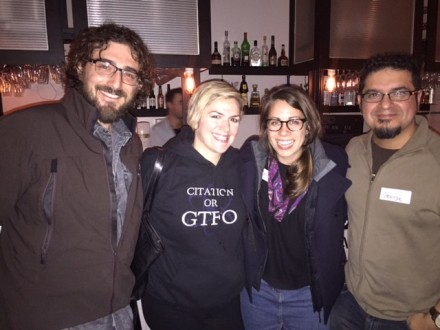Written by Sarah Keenihan
How can we survive and stay sane as professional scientists and communicators in a world where the public appetite for science may wane and wax with each new Prime Minister?
How do you get a foothold writing or podcasting or presenting science content when you don’t know what sorts of material people want to read or listen or watch, and what is already out there?
How can you meet people who work as science communicators tucked away as individuals in teeny offices within institutions, people who have the same professional drives and challenges and needs as you?
By networking.
With a new members on board and expectations high for exciting ASC times moving into 2016, a networking and end-of-year celebratory event was held by the SA committee in Adelaide in December 2015.
This session was designed quite simply to give attendees the opportunity to meet and make friends with people who are inspired by science and its communication.
And we had an ice-breaker: the 2014 Unsung Hero of Science Communication Winner, Michael Mills. Attending as his alter-ego the singing palentologist Professor Flint, Michael gave us:
“A brief and hilarious history of the role of sexual reproduction in increasing species biodiversity, the evolution of it’s associated rituals, and the strange, and sometimes awkward parallels this has for humans when engaged in networking activity!”
Awks, right? I mean, who wants to even put networking and sex in the same sentence? Well, it worked. Professor Flint convinced us that perhaps with a few tips from nature, through networking we might yet move forward to new and exciting collaborations in the world of science communications.
He told us:
The person you’re talking to might be the one who helps you get your dream project to the next step.
How do you find out?
You find out by being bold, by making the move, by singing the song, by being preemptive, by inviting them into your love garden and maybe going into their love garden too.
You may be a part of someone else’s dream. And equally they may be a part of yours.
The ‘love garden’ bit is a science reference, and relates to…oh never mind, I guess you had to be there.
A great crowd of around 50 people was in attendance, with some old and many new faces. Our new committee member Bowie (Matthew, not David sob) had the great idea of bringing along some colleagues from the Ecological Society of Australia conference also in town. It’s great to hear outsiders’ perspectives from time to time.
The formal networking aspect of the evening commenced by people moving along seats at tables every 3 minutes, but then progressed to more casual conversations at the bar and around the place.
It was fun, it was loud, and it was different to anything we’d done before.
We look forward to a great 2016 as a local committee, and as a part of our national body of Australian Science Communicators that is establishing a new way forward to help us all communicate science in novel and impactful ways.

